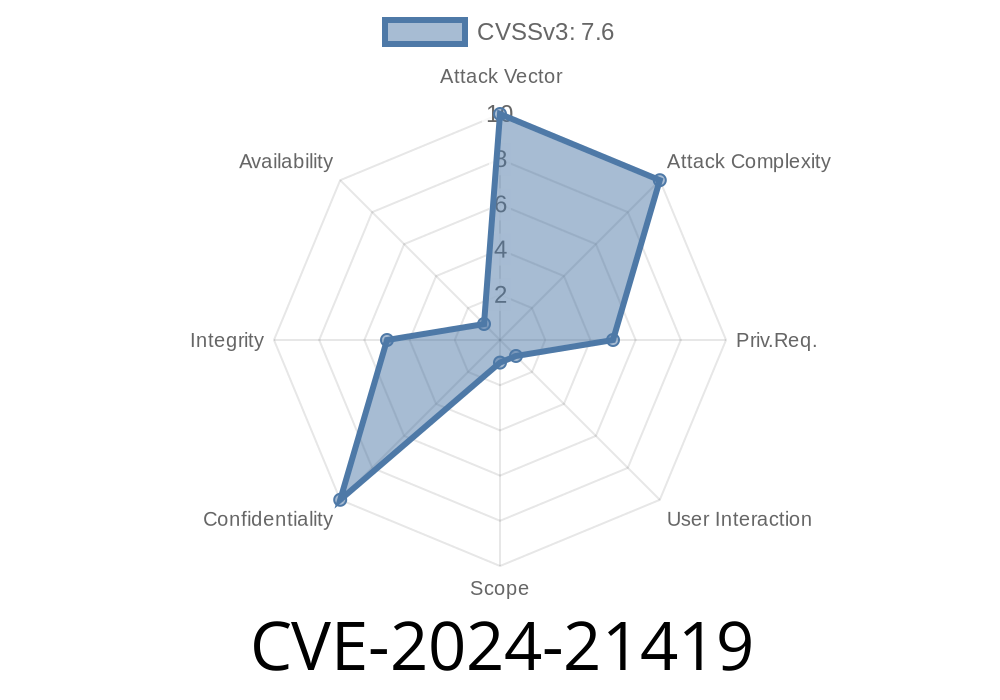If you are an organization that uses Microsoft Dynamics 365 (on-premises) for managing your customer relationships, it's time to double-check your security measures. The CVE-2024-21419 is an important vulnerability you should be aware of; it allows remote attackers to inject malicious scripts into users' web browsers via a cross-site scripting (XSS) vulnerability.
In this long-read post, we will take you through a detailed analysis of the exploit, provide a better understanding of the issue, and offer guidelines on how to mitigate the threat. Packed with snippets of code and original references, this exclusive content provides accessible information for all users, regardless of their technical know-how or experience.
Exploit Details
The CVE-2024-21419 vulnerability specifically affects Microsoft Dynamics 365 (on-premises) versions 8.2, 9., and 9.1. The issue lies in the product's lack of proper validation when handling user-supplied input. A remote attacker can take advantage of this weakness by injecting malicious scripts into the input fields of Microsoft Dynamics 365. These scripts can compromise the victim's machine by executing arbitrary code within the context of the affected user's browser.
Here's a code snippet demonstrating the exploit
<!-- Malicious payload -->
<script>alert('CVE-2024-21419');</script>
When a victim inadvertently accesses a web page containing the malicious payload, the script runs, alerting the attacker and potentially leading to sensitive data breaches.
To dig deeper into the CVE-2024-21419 vulnerability, you can refer to the official advisory provided by Microsoft's Security Response Center (MSRC):
- MSRC Advisory
Potential Risks
A successful exploitation of the CVE-2024-21419 vulnerability can result in several cybersecurity issues, such as:
1. Sensitive data theft— an attacker can access confidential user data (e.g., login credentials and personally identifiable information) by capturing HTTP cookies.
2. Account takeover— infected users' accounts could be hijacked, giving the attacker control over their profile, privileges, and activities.
3. Unauthorized actions— an attacker can perform actions on behalf of the affected user, such as modifying data or conducting financial transactions.
Mitigation Strategies
To protect your organization and users from the CVE-2024-21419 vulnerability, follow the steps outlined below:
1. Update your Microsoft Dynamics 365 (on-premises) software to the latest version. Microsoft has released patches for versions 8.2, 9., and 9.1 to address this issue. You can find the relevant updates in the Microsoft Update Catalog:
- Security Update for Dynamics 365
2. Implement strict input validation measures to prevent the injection of malicious scripts. Adopt proper data encoding and sanitization techniques to ensure input data is trustworthy. The OWASP XSS Prevention Cheat Sheet provides comprehensive guidelines for mitigating XSS vulnerabilities.
3. Educate your users about the potential risks and the signs of XSS attacks. Encourage them to report any suspicious activities or discrepancies in their account.
4. Regularly perform security audits and vulnerability assessments on your Dynamics 365 deployment to identify potential risks and address them proactively.
Conclusion
The CVE-2024-21419 vulnerability in Microsoft Dynamics 365 (on-premises) can pose serious risks to your organization and its users. By understanding the exploit and embracing robust security measures, you can prevent and mitigate the vulnerability.
Stay abreast of the latest cybersecurity news, updates, and threats by following reputable sources like Microsoft's Security Response Center (MSRC) and the National Vulnerability Database (NVD).
And never forget, knowledge is power— the more you know about the digital threats lurking out there, the better you can protect your valuable data and resources.
Timeline
Published on: 03/12/2024 17:15:50 UTC
Last modified on: 03/12/2024 17:46:17 UTC
